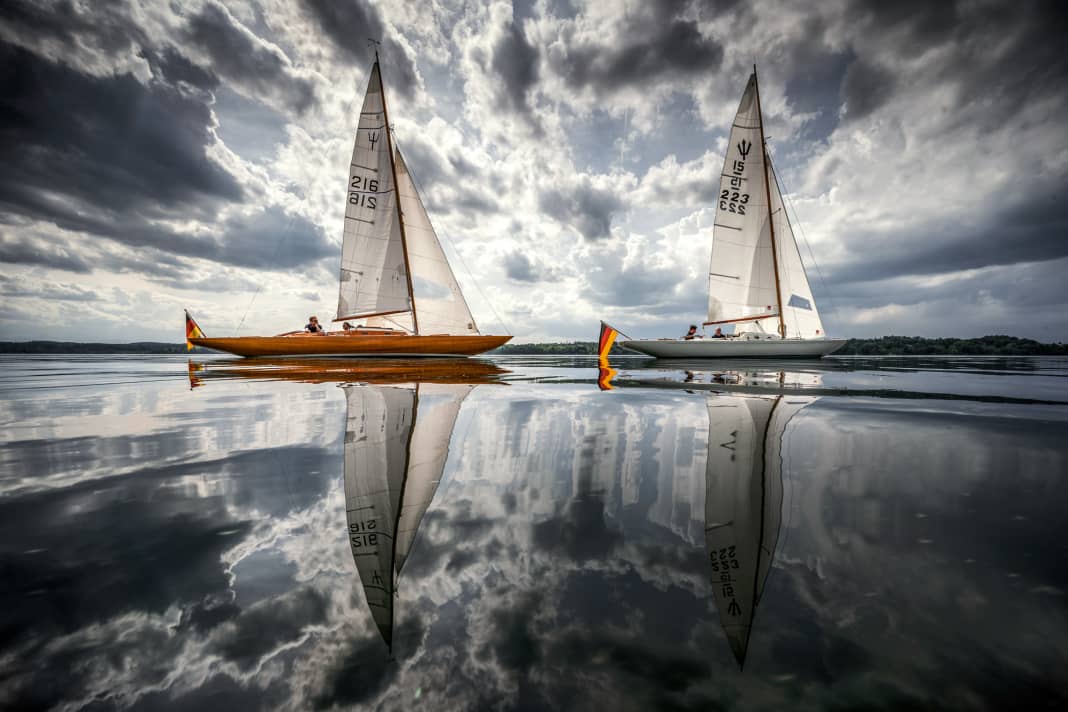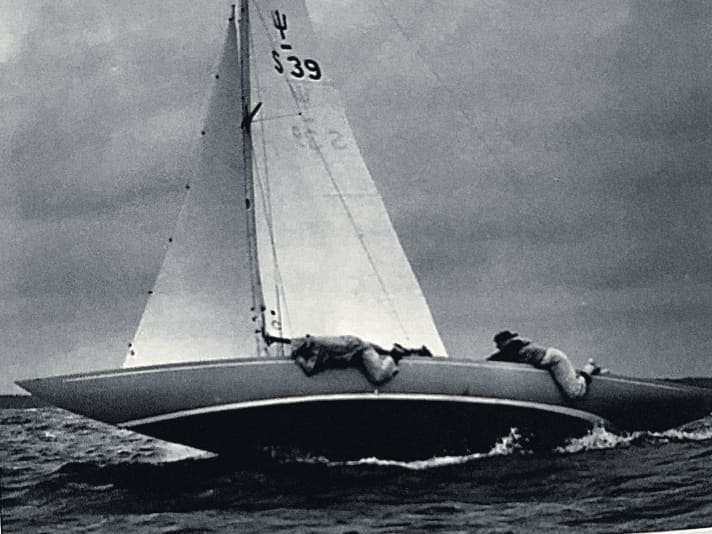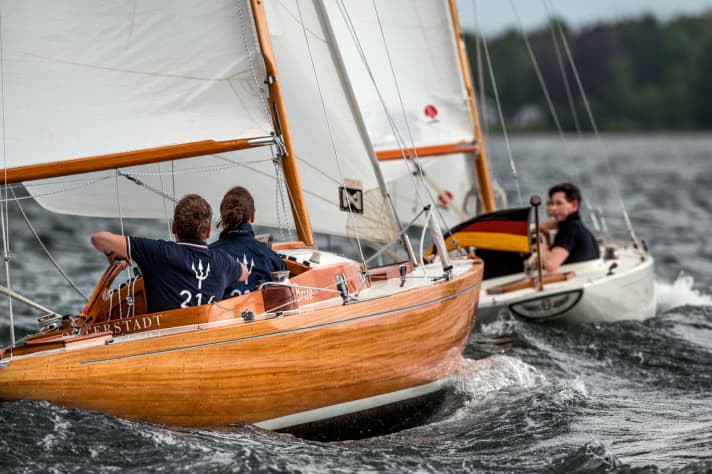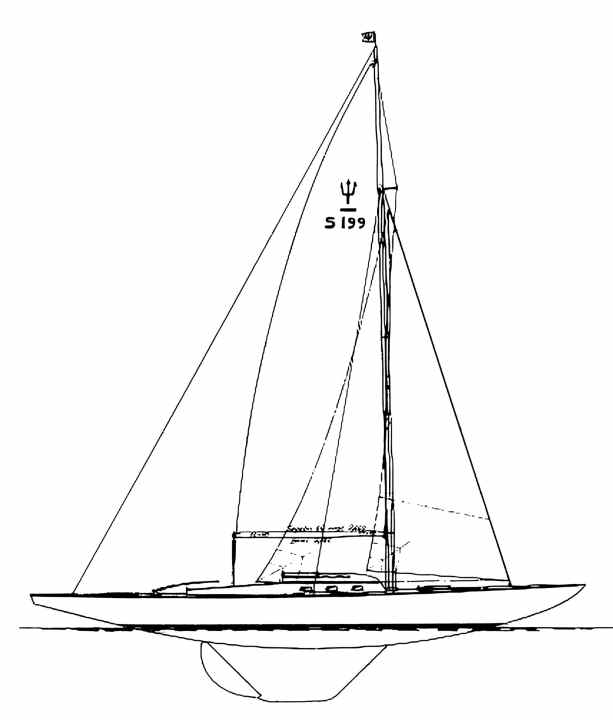Neptune cruiser: Classic skerry cruiser with trident - made of wood or GRP
Lasse Johannsen
· 07.04.2024






As if pushed by a ghostly hand, two skerry cruisers move across Lake Starnberg. On this early summer's day, its surface resembles a mirror. Not a breath of air leaves a trace on the water. And yet the long, slender boats with the distinctive trident in the mainsail make very slow progress. There is a reverent silence on board. The sailors watch the play of the clouds rising ever faster behind the mountain massif on the lake shore, as flashing lights all around begin to warn of wind. Wind?
And then it starts. Literally out of the blue, the Bavarian wind gods send a greeting to the sea dwellers from the far north. They routinely parried what was happening. From one moment to the next, they dash across the lake behind a white bow wave, which suddenly seems to be boiling. Like twins, they dance side by side at the same speed and with the same movements, and only the colour of the hulls - one white and one wooden - tells the viewer at first glance that each of the two sister ships has its own personality.
Neptune cruisers are a separate class within the archipelago cruisers
Only insiders will recognise that these are two rare representatives of the approximately 275 Neptune cryssars still sailing. The design dates back to 1938 and is recognised by the skerry cruiser association as a class-compliant 15-square-metre skerry cruiser. However, as a standardised class with strict building regulations, the Neptune cruisers form a separate class within the 15-square-metre archipelago cruisers, which is still very active in regattas today.
The wooden "Brise", built in 1969, is at home on the Otterstädter Altrhein near Speyer. Her sister "Swansjön", built from GRP in 1976, moved here to the Alpine lake more than ten years ago. Georg Hagemeyer, contact person for the German owners, was looking for a Neptune cruiser in 2009 and found the ship in eastern Sweden.
Now he sits in the small cockpit and enjoys the fresh summer wind of over 20 knots, reminiscent of "Swansjön's" homeland, which is so rare here in the deep inland. Neither the boat nor the crew are bothered by the fact that the large genoa is set instead of the small jib.
Attention is required at the tiller of the Neptune cruiser
However, attention is required at the tiller. The small archipelago cruiser sails extremely agilely, reacting sensitively to the rudder and the slightest change in wind. It is not greedy to windward. If the tiller is released for a short time, the boat sails straight ahead unperturbed when the sails are well adjusted. However, the other expectations of the classic behaviour of a long keeler quickly prove to be wrong. When tacking, the boat almost turns on its disc.
The reason is the design. Less than six metres of the nine-metre hull length plunges into the water - without the ply - and the centrally positioned keel, together with the attached, large rudder blade, is shorter than three metres. With a total weight of just over one tonne - half of which is ballast - the Neptune cruiser is also very light. And so it climbs nimbly over the short, steep waves that build up and takes on little water.

Hagemeyer came across the Neptune cruiser while searching for a classic of the type and size of a kite. "But I wanted to be able to spend the night on board," says the Munich-based architect. Another criterion was that the price should not be as high as the Lacustre and that the boat should be easy to sail alone, so that the Hai boat with its forecastles was also out of the question. The Neptune cruiser therefore quickly came onto the scene. "A real archipelago cruiser," says Hagemeyer, "a magic word for me!" Even before he inspected the first boat, he was captivated by the special history of the Neptune cryssars.
The first Neptune cruiser was to take painter Einar Palme to the archipelago
It was commissioned by the Swedish designer Lage Eklund. In 1938, he created a boat in the style of the time for his friend, the painter Einar Palme. However, Palme wanted it to be easy to sail alone and to have room for all of the artist's work equipment. Easels, drawing and painting utensils, luggage and sleeping berths for Palme and sometimes a fellow sailor. In order to be able to navigate to the more remote places in the archipelago, a shallow draught and exceptional manoeuvrability were also required. The result was "Après Vous", with which Palme travelled the Stockholm archipelago and Lake Mälaren for almost thirty years.
The boat owes its popularity to the fact that it could be measured as a 15-metre skerry cruiser, but was cheaper to build. Sailing clubs in Uppsala and Gävle had sister ships built, and numerous Swedish yacht clubs opted for the Neptune cruiser when it came to raffling off a lottery boat; a very common form of promoting young talent at the time: the proceeds from the sale of raffle tickets exceeded the price of the boat, the profit went to youth work, and the raffled boat was reinforcement for the new regatta class.
Seaworthy, but with limited space
In this way, the beautifully shaped Neptune cruiser quickly spread. Word of its good sailing characteristics spread and soon the boat also had a reputation for being extremely seaworthy, which further fuelled its popularity. The fact that the space below deck was limited by today's standards was not a problem at the time. As late as 1958, YACHT wrote: "Thanks to its high freeboard and width, the 'Neppe' is very spacious - especially when the mast is placed on deck, as permitted by the class regulations."
There's as much space in the saloon as there is under the dining room table at home." (Proverb among Neptune owners)
In fact, travelling comfort on the Neptune cruiser is only guaranteed with the obligatory cake stand. Although there are four fixed berths below deck, usually also fitted with numerous lockers, the space is so small that there is a saying on the scene that there is as much room in the saloon as there is under the dining room table at home.

At the beginning of the 1940s, the Neptunkryssarförbundet was founded as its own class association outside the Swedish skerry cruiser association. And just five years later, the "Neppe", as the owners affectionately call their boat, is awarded Swedish championship status. Since then, the sail mark - Neptune's trident - no longer indicates that the boat is a genuine 15 square metre skerry cruiser.
The Neptunkryssarförbundet still exists today. Since 1976, the class association has published the members' magazine "Nepparnytt" four times a year and maintains the website www.neptunkryssare.se.
First pine, then mahogany, finally GRP
One of the most important concerns of the class association is to ensure that the Neptun cruiser remains an affordable boat right from the start. Initially, this mainly concerns the construction, which requires around 1,200 hours of labour. Initially, only cheaply available domestic pine was authorised for the outer skin planking. The 200 or so boats from this period can be recognised by their mostly white-painted outer skin. It was not until 1962 that mahogany was also authorised, and oak and steel in composite continued to be used. Around 20 more solid wood boats are built in this way.
The first GRP construction is produced in 1976. The mould was taken from the last traditionally built Neptune cruiser, No. 217 "Diva", which had been built two years earlier. Its deck was given a more modern design in view of the planned project. The superstructure was modelled on that of the dragon and the coaming lowered.
Neptune cruisers made of wood and GRP are on a par
Apart from that, the boat resembles the traditionally built model like a hair to another. The weight and its distribution in the hull, its dimensions, the rig, everything corresponds exactly to the building regulations, so that the equality of opportunity quickly becomes apparent when sailing without compensation. To this day, the national championships of what is now Sweden's largest standardised class are sometimes won by a boat made of GRP and sometimes by one traditionally built from wood. Around 70 boats have been built from plastic to date.

The self-image of a boat that is cheap to sail is still the DNA of Neptune cruiser sailors today. And so modernisations in the class have always had a hard time. Until 1967, the genoa was unfurled to windward instead of a spinnaker on rough courses and the jib was set to leeward. The aluminium rig also only received the blessing of the class association in 1982. Another change in 2006 was the outhaul harness, which saw the mainsheet traveller track disappear more and more frequently - its main use with the narrow-cut mainsail is to provide support when outhauling.
Neptune cruiser "Brise" is still completely original today
The "Brise" was built in 1969 as the penultimate all-wood boat in mahogany on oak and steel frames, says owner Heiko Schultz. The crews of both boats have moored up again and are sitting on the terrace of the Seeshaupt Yacht Club, the sails are drying on the lawn in front.
"The first owner of the 'Brise' was Styg Fligare, an active regatta sailor who named the boat 'Manana' and won the Neptunkryssarpokalen series in 1972," says Schultz. He himself found the boat on Lake Constance in 2010. During a holiday in Brittany, Schultz had seen a small classic with a lot of overhang. A regional class, similar to the 15sqm SNS (Serie Nationale Suisse). In his search for something comparable, he came across the Neptune cruiser, then called "Maja", on Lake Constance.
"I looked at it and immediately thought it was the right boat. Big enough for me and my two children, but still doable, small cabin, trailerable and, as an archipelago cruiser, also suitable for the Baltic Sea."
Schultz has sailed the "Brise" as a cruising boat ever since and takes part in classic regattas. He has sailed in the Western and Eastern Archipelago as well as at the Classic Week, the Lake Constance Traditionswoche and now on Lake Starnberg. He didn't have to change anything on the boat, which is still completely original today. He only had the paintwork professionally renewed, the underwater hull overhauled by a boat builder, and the rig, which was equipped for racing, was slightly adapted for cruising.
Around 30 of the 300 Neptune cruisers still sailing today are based in Germany
Georg Hagemeyer has also travelled around Sweden on "Swansjön". With his two daughters on board, he explored Lake Mälaren extensively before taking the boat overland to Bavaria.
According to both Neptune cruiser enthusiasts, the differences between the wooden boats are considerable in many details, depending on the shipyard and year of construction, apart from the identical dimensions. The plastic boats differ mainly in their fittings and condition. This is often significantly worse than the traditionally built sister ships, which are valued as classics.
Around 30 Neptune cruisers are based in Germany today. And even though they are not an active regatta class here, unlike in Sweden, they are loved and preserved by their owners as little gems.
The Neptune cruiser class
The brief given to designer Lage Eklund in 1937 was to design a boat that could be sailed alone across the sea even in strong winds. At the same time, it had to be manoeuvrable and have a shallow draught so that it could also reach remote corners of the archipelago. Inside, the boat needed to be spacious and offer room for up to three people to spend the night. The result was a 15-metre archipelago cruiser with a slightly higher freeboard - the Neptune cruiser
Technical data Neptune cruiser

- Design engineer: Location Eklund
- Length: 9,00 m
- Waterline length: 5,85 m
- Width: 1,92 m
- Freeboard: 0,55 m
- Depth: 1,20 m
- Displacement: 1,15 t
- Ballast: 0,54 t
- sail area: 22 square metres
- Mainsail: 12 square metres
- Genoa: 11.5 square metres
- Fock: 7 square metres
- Spinnaker: 30 square metres
Website of the German owners: www.neptun-schaerenkreuzer.de

